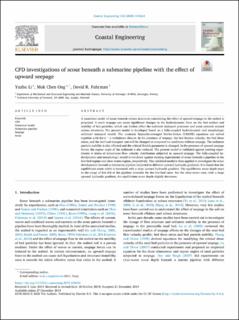| dc.contributor.author | Li, Yuzhu | |
| dc.contributor.author | Ong, Muk Chen | |
| dc.contributor.author | Fuhrman, David R. | |
| dc.date.accessioned | 2021-02-22T13:31:16Z | |
| dc.date.available | 2021-02-22T13:31:16Z | |
| dc.date.created | 2020-09-23T13:41:12Z | |
| dc.date.issued | 2020-12 | |
| dc.identifier.citation | Li, Y., Ong, M.C., Fuhrman, D. (2020) CFD investigations of scour beneath a submarine pipeline with the effect of upward seepage. Coastal Engineering, 156, 103624. | en_US |
| dc.identifier.issn | 0378-3839 | |
| dc.identifier.uri | https://hdl.handle.net/11250/2729550 | |
| dc.description.abstract | A numerical model of scour beneath subsea structures considering the effect of upward seepage in the seabed is proposed. A small seepage can cause significant changes to the hydrodynamic force on the bed surface and stability of bed particles, which can further affect the sediment transport processes and scour patterns around subsea structures. The present model is developed based on a fully-coupled hydrodynamic and morphologic sediment transport model. The unsteady Reynolds-averaged Navier-Stokes (URANS) equations are solved together with the turbulence closure. In the presence of seepage, the bed friction velocity, the bed shear stress, and the bed load transport rate will be changed as compared to conditions without seepage. The sediment particle stability is also affected and the critical Shields parameter is changed. In the presence of upward seepage forces, the repose angle of the sediment is also reduced. The present model is validated against existing experiments in terms of streamwise flow velocity distribution subjected to upward seepage. The fully-coupled hydrodynamic and morphologic model is validated against existing experiments of scour beneath a pipeline in the live-bed regime and clear-water regime, respectively. The validated model is then applied to investigate the scour development beneath a submarine pipeline subjected to different upward hydraulic gradients. It is found that the equilibrium scour width is increased with a large upward hydraulic gradient. The equilibrium scour depth stays in the range of 0.6–0.8 of the pipeline diameter for the live-bed cases. For the clear-water case, with a large upward hydraulic gradient, the equilibrium scour depth slightly decreases. | en_US |
| dc.language.iso | eng | en_US |
| dc.publisher | Elsevier Ltd. | en_US |
| dc.rights | Navngivelse 4.0 Internasjonal | * |
| dc.rights.uri | http://creativecommons.org/licenses/by/4.0/deed.no | * |
| dc.subject | CFD | en_US |
| dc.title | CFD investigations of scour beneath a submarine pipeline with the effect of upward seepage | en_US |
| dc.type | Peer reviewed | en_US |
| dc.type | Journal article | en_US |
| dc.description.version | publishedVersion | en_US |
| dc.rights.holder | © 2020 The Authors. | en_US |
| dc.subject.nsi | VDP::Teknologi: 500 | en_US |
| dc.source.pagenumber | 12 | en_US |
| dc.source.volume | 156 | en_US |
| dc.source.journal | Coastal Engineering | en_US |
| dc.identifier.doi | 10.1016/j.coastaleng.2019.103624 | |
| dc.identifier.cristin | 1832572 | |
| dc.source.articlenumber | 103624 | en_US |
| cristin.ispublished | true | |
| cristin.fulltext | original | |
| cristin.qualitycode | 2 | |

